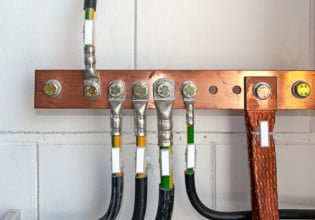Securing the Grid and Renewable Resources will be Key for Energy Security
Los Alamos National Laboratory Director Charlie McMillan told a gathering of energy executives today that securing the electrical grid is a major concern now and it's only becoming more serious. McMillan showed a Los Alamos device called a QKarD that uses principles of quantum cryptography to send secure signals at the speed of light. Single photons are used to produce secure random numbers between users, and these random numbers are then used to authenticate and encrypt the grid control data. QKarD was successfully tested recently at the University of Illinois to send signals between grid components separated by more than 12 miles of optical fiber. Securing grid control systems with quantum cryptography would make them far less vulnerable to those attempting to interfere with signals between generators, control centers and substations.
"If you look back at the last year, there were several hundred attacks on critical infrastructure," McMillan said, addressing attendees at the Deloitte Energy Conference near Washington, DC. "More than 40 percent of those attacks were on the energy sector."
Resilience and reliability of the electrical grid have become key energy security concerns at the Laboratory and are important focus areas in global security. Experience with massive amounts of data, complex systems and security technology involved in nuclear weapons research are now providing insights for grid security, McMillan said.
"In the time it takes me to say this sentence, the external firewalls of Los Alamos will be challenged hundreds of times by adversaries. Our systems, and yours, are very attractive." McMillan said. "But encrypting control signals on the grid is particularly challenging because any encryption scheme must be able to meet competing standards for very rapid response and high security."
Novel methods for controlling the electric grid are needed to accommodate new energy sources such as renewables whose availability can fluctuate on short time scales. This requires transmission of data to and from control centers; but for grid-control use, data must be both trustworthy and delivered without delays. The simultaneous requirements of strong authentication and low latency are difficult to meet with standard cryptographic techniques. New technologies that further strengthen existing cybersecurity protections are needed.
Quantum cryptography provides a means of detecting and defeating an adversary who might try to intercept or attack the communications. Single photons are used to produce secure random numbers between users, and these random numbers are then used to authenticate and encrypt the grid control data and commands. Because the random numbers are produced securely, they act as cryptographic key material for data authentication and encryption algorithms.
At the heart of the quantum-secured communications system is a unique, miniaturized QC transmitter invention, known as a QKarD, that is five orders of magnitude smaller than any competing QC device. Jane Nordholt, the Los Alamos principal investigator, put it this way: “This project shows that quantum cryptography is compatible with electric-grid control communications, providing strong security assurances rooted in the laws of physics, without introducing excessive delays in data delivery.â€
A late-2012 demonstration at UIUC showed that quantum cryptography provides the necessary strong security assurances with latencies (typically 250 microseconds, including 120 microseconds to traverse the 25 kilometers of optical fiber connecting the two nodes) that are at least two orders of magnitude smaller than requirements. Further, the team’s quantum-secured communications system demonstrated that this capability could be deployed with only a single optical fiber to carry the quantum, single-photon communications signals; data packets; and commands. “Moreover, our system is scalable to multiple monitors and several control centers,†said Richard Hughes, the co-principal investigator from Los Alamos.
The TCIPG cyber-physical test bed provides a realistic environment to explore cutting-edge research and prove emerging smart grid technology in a fully customizable environment. In this demonstration, high-fidelity power simulation was leveraged using the real-time digital simulator to enable hardware in the loop power simulation to drive real phasor measurement units (PMUs), devices, deployed on today's electric grid that monitor its operation.
“The simulator provides a mechanism for proving technology in real-world scenarios,†said Tim Yardley, assistant director of test bed services. “We're not just using perfect or simulated data, so the results demonstrate true feasibility.â€
The power simulation was running a well-known power-bus model that was perturbed by introducing faults, which drove the analog inputs on the connected hardware PMU. The PMU then communicated via the standard protocol to the quantum cryptography equipment, which handled the key generation, communication and encryption/decryption of the connection traversing 25 kilometers of fiber. A phasor data concentrator then collected and visualized the data.
“This demonstration represents not only a realistic power model, but also leveraged hardware, software and standard communication protocols that are already widely deployed in the energy sector,†said William H. Sanders, the Donald Biggar Willett Professor of Engineering at UIUC and principal investigator for TCIPG. “The success of the demonstration emphasizes the power of the TCIPG cyber-physical test bed and the strength of the quantum cryptography technology developed by Los Alamos.â€






